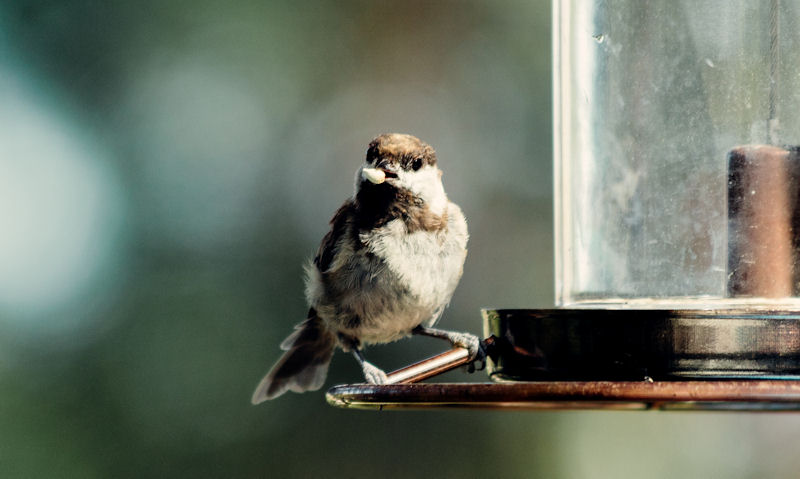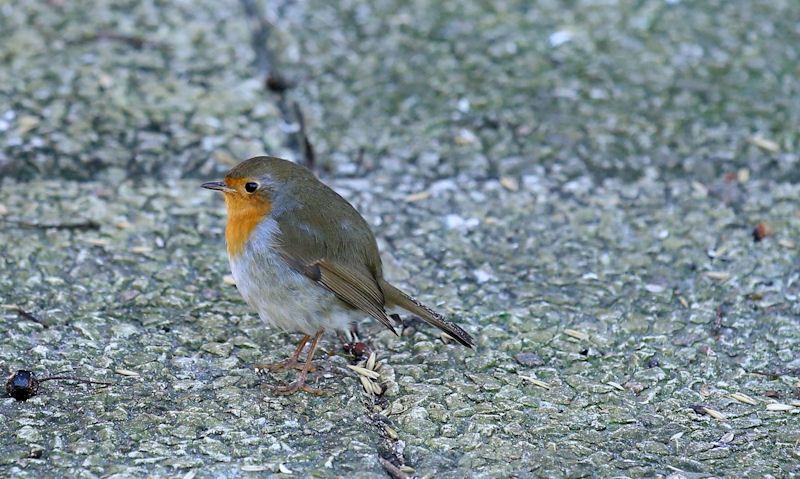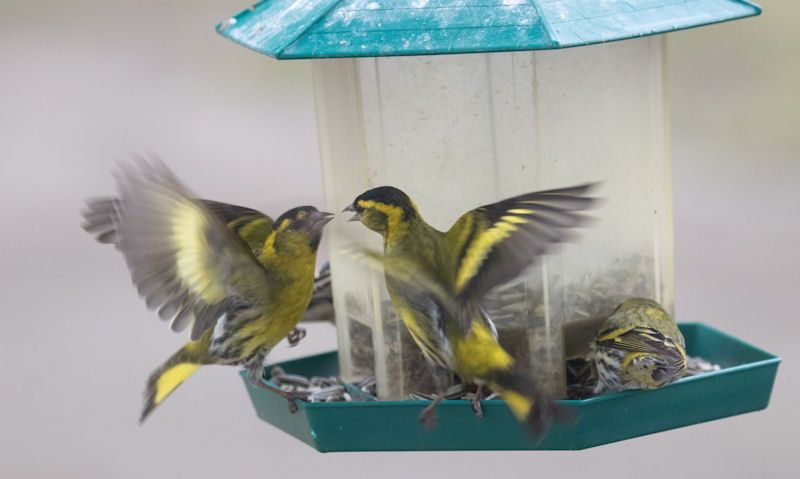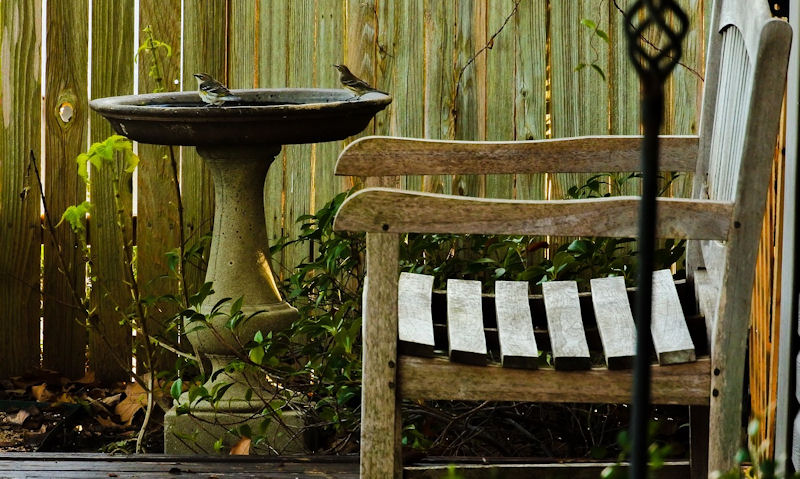Ground feeding garden birds in the UK
Its important to know which common garden birds are ground feeding birds as to know what food you can lay out for them, or identify what birds are feeding out of your garden.
Up to 13 ground feeding garden birds in the UK with Robin and House Sparrow being the most common. All species are seen all year round in the UK expect the Siskin which is only found in England in winter. Other than them, you can see a Greenfinch, Blackbird, Chaffinch, Song Thrush, Dunnock and Starlings.
Set the ideal environment to attract birds to your garden for birds who will almost exclusively feed off the ground, though some will give the bird feeders a go.
If not then expect to see those who can indeed use bird feeders or those who happily feed on the lawn, the patio or seek out worms on a dirt patch.
I've identified up to thirteen ground feeding birds, but their are far fewer for most of us to experience - as we can't cater to all species as they require a certain habitant.
Wrens are the most common garden bird in the UK, but most of us won't see them because not only are they quick, but the garden location needs to be near open land for Wrens to ever think about coming to the garden to feed.
However, what we can control is the likelihood of mostly Robins and House Sparrows coming to our garden to feed, so concentrate your effort on them.
But again, some of you may experience higher numbers of different species, so its therefore important to focus on their diet, not species that rarely come to your garden.
I would then make sure to use any type of wild bird seed mixes, or why not sunflower seeds in the hearts or black variety.
Suet bird food is popular so to buy it in pellet form can be easier to throw over the garden lawn.
And if using peanuts, it imperative to crush up half as to make its easier for certain species to consume, as well has their young in the nesting season to prevent choking.
To feed exclusive ground feeding birds in a tidier manner, consider use of a ground bird feeder to hold all wild bird food.
Ground feeding bird footage
Garden birds who feed out of a garden tend to not focus on one part when food can be found in many crevices or surfaces.
Female house sparrow seen in this footage heads to the garden perimeter with dried up dirt, before hopping over the path to peck at the lush green grass.
Later on she visits a muddy patch with post inserted located in a shadow area. Its possible then the mud is not dried up so much so she may be more successful. And that is actually what happens as she finds a worm.
You see your garden landscape can effect where ground feeding birds seek out food, with more damper, shadow areas seen to be more successful.
Ground feeding birds table
Up to thirteen ground feeding garden birds may possibly visit your garden in the UK; although numbers are few and far between depending on where you are in the country.
| Bird: | Pairs: | UK Residence: |
|---|---|---|
| Blackbird | 5.1M | Nationwide |
| Chaffinch | 6.2M | Nationwide |
| Collared Dove | 990K | Nationwide |
| Dunnock | 2.3M | Nationwide |
| Greenfinch | 170K | Nationwide |
| House Sparrow | 5.3M | Nationwide |
| Mistle Thrush | 170K | Nationwide |
| Robin | 6.7M | Nationwide |
| Siskin | 410K | Nationwide |
| Song Thrush | 1.2M | Nationwide |
| Starling | 1.8M | Nationwide |
| Woodpigeon | 5.4M | Nationwide |
| Wren | 8.6M | Nationwide |
Resident across UK
Few of us won't be far from any of these remarkable British common ground feeding birds, with many of us lucky enough to entice any one species into our garden.
And while there's are up to thirteen garden birds in all, not all can come to any one garden.
Seen across the whole of the United Kingdom, the habitant is important to any wild bird species, so those in more busy urban areas will probably see less, while those in quiet towns or villages may open up your garden to more birds.
In all though, any one of these ground feeding birds may very well pop in to your garden, with an occasional rare visitation.
While all British birds mentioned are common garden birds seen all year round, most parts of inland Scotland and in Mid Wales - won't see any of these birds at all.
Seasonality is important, as the seen all year Siskin will only be seen in England in winter time; whereas Scotland, most of Northern Ireland and Wales will receive visitation 365 days of the year.
Song Thrush on the otherhand can only be seen in an already rare upper, Scottish Highlands in the summer but seen across the rest of the UK all year.
Contenders to use Feeders
Ground feeding garden birds they may be, so for those who only feed off the ground you may never know about it.
Agile, prefer to visit when it quiet more shy garden birds can dive in and out in an instant, so they are gone before you know it.
This isn't so for many common ground feeding birds as you'd probably come to know the more common Robin and House Sparrows occupying your hanging bird feeders - including the rarer Siskin or Greenfinch.
What these birds can do is happily feed off the ground, but as the food source is contained within tubes or mesh feeders - is more convenient and safer - to feed higher up in the garden.
Pigeons are seen to attempt to feed on hanging bird feeders as you may know, but are not seen to be very successful.
Contenders to use the hanging bird feeders on the bird feeding station or a feeder hanging off a wall bracket would then be the Robin or House Sparrow across the whole of the UK.
Not all ground feeding birds have the capacity to perch on feeders to feed, but they may be able to land under the bird table which is where else you may find them.
Robin is NOT fussy
Robins are a contender to use the bird feeder full of peanuts, fat balls or seeds, as the Robin has the capacity to use either option.
There is nothing else you need to do to attract Robins to your garden other than offering these types of wild bird food.
Among the herds of House Sparrows that commonly surround the feeders on a daily basis, its the red breast Robin seen amongst them.
Not just for Christmas either, as the Robin is an all year round wild bird, so can be seen on the feeder, under the bird table or feeding off the ground.
For me, I've never seen a Robin feed off the ground believe it or not, but I do see them feed exclusively off the hanging bird feeders only.
What this can relate too is the feeding area feels safer, so Robins proceeds to use that.
But it can be the food is in better condition, and in larger numbers; so why feed on fewer scraps on the ground when food is plentiful above it.
If you don't often see Robins - who are classed as ground feeding birds in the wild - feed off your feeders, it could be the food in use is not suitable for them, or the feeder in question may very well be restricted in some ways.
Its therefore possible the Robin finds it easier to feed off the lawn or patio below it.
House Sparrows in numbers
Seeing as House Sparrows are the fifth largest breeding pairs in the UK, its any wonder why we seen them in larger numbers in our gardens than any bird species.
Actually, you might think you see more House Sparrows in too many numbers, and this is probably correct as House Sparrows tend to visit our garden more often with the capacity to feeding off the ground, use hanging bird feeders or the bird table.
I used to think it would be nice to receive more visits by other species on my bird feeding station for a change - but I don't think like this any more as you should really appreciate what you get.

Continue to feed them as you do then as Robins and Chaffinches are in similar numbers, so may be seen in the scruffle once in a while.
I now appreciate all my House Sparrows as they keep me on my toes when looking out for rarer species seen amongst them.
Marked mostly with brown feathers with white stripes and a black marking on the face for the male. The female can be mistaken for the male, but its important to know the female doesn't have the black markings under the beak on her face.
What to feed ground feeding birds
So many wild bird species come to our gardens but unfortunately not all of them are on the same diet - so you will need to cater to them all.
To be safe, you'd want to focus primarily on cheaper seed mixes, which can be gobbled up by all but one, the Wren.
More specialty seeds can be used such as sunflower hearts which are eaten up by most, or black sunflower seeds consumed by Collard Doves, Chaffinches, House Sparrows, Greenfinches and Siskins - including niger seeds also suitable for Siskins.
Be sure to use wild bird seed mixes up high in feeders for a number of birds, but it is important seeds are scattered over the lawn for the ground feeding birds to access.
What else is vital for ground feeding birds to feed off are dried mealworms for birds, while wiggling live mealworms would go down a treat with most species.
Fat balls are associated with use in bird feeders, but they can still be broken up and thrown over the ground - or why not use suet pellets to scatter or other kinds of wild bird suet products.
That brings us to your final option of laying out peanuts - crushed or left whole - over the ground for many of the common ground feeders.
Divert Pigeon or Doves attention
I understand you are less willing to cater to Pigeons or its near cousin the Collard Dove, so remember it would be impossible to not have them come to your garden.
While they will attempt to feed off the bird feeders hanging up, they will indeed have no trouble eating off the ground, as they are ground feeding birds after all.
To avoid them going hungry, you could possibly lay out food in an area of the garden that is at a distance from the feeders - so you can concentrate offering small common garden birds food - while keeping the larger, more nuisance wild birds at bay.
Divert their attention then by laying out feed especially for them in another area of the garden.
It won't be possible to keep pigeons away if you go down this route of feeding birds on the ground - but so too can crows come along to feed.
I would then concentrate your efforts of feeding garden birds in feeders, while catering to ground feeding birds in a more restricted way - as to make sure the larger birds don't stop by, while causing a nuisance of themselves.
To summarise
Amazingly, its only the thirteen ground feeding birds that are likely to be seen feeding off our lawns or patio, but the numbers in total are huge.
If I combine all breeding pairs in the UK, that brings the tally up to way over 40 million birds who prefer to feed in gardens off the ground.
Ground feeding garden birds they may be, but a few are capable of using, or prefer to - use our hanging bird feeders or the bird table...
Its important then to setup bird feeders as it can offer a safer way to feed.
Gardens with plentiful greenery including a lush lawn that is left untouched for most of the day will see more visitation, so therefore you'd see more ground feeding birds pecking at the ground for worms after a rainfall or creepy crawlies of any kind.
Of the thirteen ground feeding birds in the UK, it possible most of us could see all species every day of the year. Whereas the Siskin is only seen in winter in most of England, or Starlings only seen in Mid Wales in summertime.
But apart from the few, most ground feeding birds are commonly seen across Britain.
That is less so the Wren, and while they are technically the most common bird in the UK, they are seen less because they are more agile, yet far more shy. And they only prefer to feed in gardens near wooded areas, or next to open parks.
What bird species most of us are likely too see more often is the Robin and of course House Sparrows - of whom never seem to fail to arrive at the bird feeders.
Keep most of them happy by offering cheap seed mixes to use on the ground or in the feeder - while suet products and peanuts are an option for few of them.


